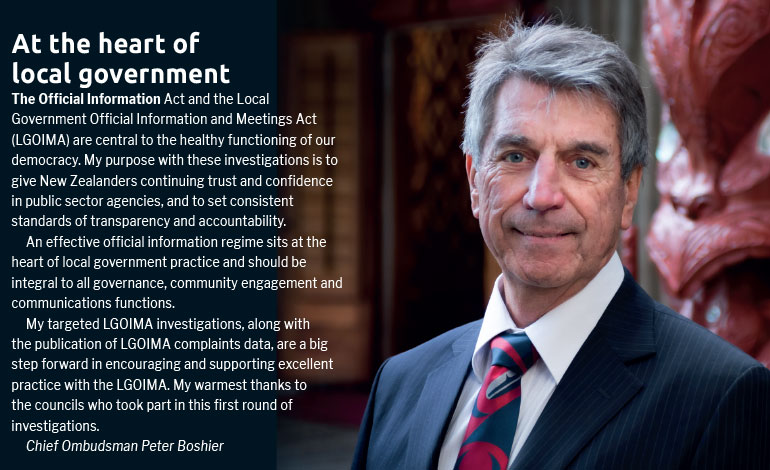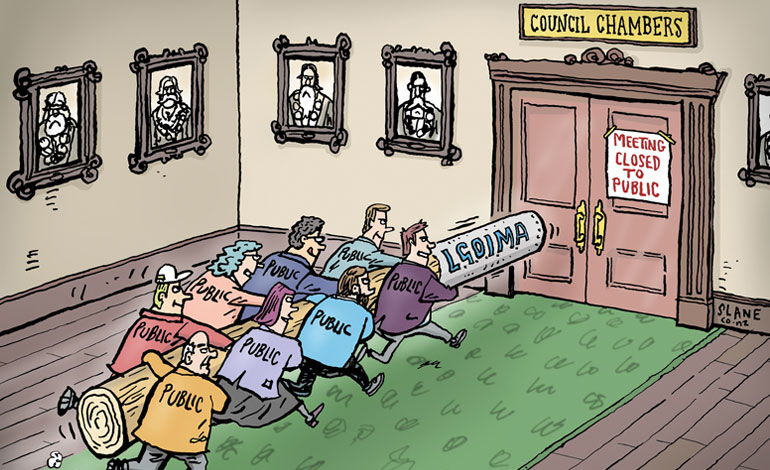How well are councils working with the Local Government Official Information and Meetings Act (LGOIMA)? This year [2019] the Chief Ombudsman launched his first round of in-depth investigations. Here are the results to date.
When New Zealand introduced freedom of information legislation in 1982, in the form of the Official Information Act, it turned the existing law – the Official Secrets Act of 1951 – on its head.
The Official Secrets Act was based on the premise that all official information should be withheld from the public, unless good reason existed to release it.
The Official Information Act (OIA) reversed this premise: official information should be available to the public, unless there is a conclusive, administrative or good reason for withholding it.
An example of a conclusive reason is if release of the information would prejudice the maintenance of the law. An administrative reason could be that the information will soon be publicly available.
Good reasons include protecting someone’s privacy or avoiding unreasonable prejudice to a commercial position – and must always be weighed against the public interest.
Five years after the OIA came into law, its local body counterpart, the Local Government Official Information and Meetings Act (LGOIMA), was introduced.
With some changes to suit the requirements of local government, LGOIMA meant the same standards of accountability and openness applied across both local and central government.
A crucial feature of our official information law is that if someone isn’t happy with the response to their information request – for example, if the response takes too long, or they disagree with a decision to withhold information – they can complain to the Ombudsman, who will work to resolve and investigate if necessary.
For the past three years, the Ombudsman has published regular data on the number of OIA complaints received about central government agencies, and their outcomes.
This year, the Ombudsman started publishing LGOIMA complaints data as well.
There’s important context to the local authority complaint numbers (165 to the Ombudsman in the first six months of 2019), particularly when they’re set against the thousands of LGOIMA requests councils receive every year.
But the complaints data is useful for identifying trends and allowing councils to review their own performance.
Another first this year is that the Chief Ombudsman launched his first round of in-depth investigations to look at how councils are working with LGOIMA.
Six councils were chosen for this first round of investigations, covering a range of size, structure, and urban/rural mix. Investigators immersed themselves in the daily mahi: following every step of a LGOIMA or Land Information Memorandum request, reviewing LGOIMA policies and resources, and interviewing and surveying staff, elected members and the public.
The resulting reports highlight what’s working well and offer suggestions for improvement, across a range of areas important for good LGOIMA practice, from leadership to record keeping and capability.

Ainslie Fenwick, manager of the Chief Ombudsman’s official information practice investigations team, says one of the most challenging issues for councils, as it can be for central government, is to understand that every request for information is a LGOIMA request – and to treat it accordingly.
“For example, every media request for information held by the council needs to be handled under the provisions of the LGOIMA,” she says.
“We’re not telling people they need to put every media query through a formal LGOIMA process, especially when the information can be provided by a member of a media team immediately. Staff just need to know that the rules in LGOIMA still apply.
“For example, if you can’t provide all the information a journalist asks for, under the LGOIMA you need to tell the journalist why you’re not providing it, and you have to inform them of their right to complain to the Ombudsman about your decision.
“Treating all your queries as LGOIMA requests, and including them in public reporting will also give a much truer picture of a council’s responsiveness with information,” she says.
Ainslie says she and her team also encourage all councils to consider the proactive release of information – something several local authorities already do very well.
“There’s nothing in the LGOIMA that prevents information being released before it’s asked for”, she says. “In fact, the LGOIMA aims to progressively increase the amount of information shared with the public.
“Some councils already publish things like their LGOIMA and media responses, the results of resident satisfaction surveys, and their performance measures – not because the law requires it, but in the interests of open and informed engagement with their communities.
“Another way councils can ensure they are being as open and transparent as possible, is by considering when reports from public-excluded council meetings can later be released. This goes a long way towards building trust and enhancing a reputation for openness, even if the information being published is not uniformly positive for the council.”
Ainslie emphasises the value of councils developing a clear and strong policy that underpins and promotes proactive release, builds institutional knowledge, and builds a council’s reputation for openness.
As a minimum, the policy would set out what kind of information a council intends to proactively release, when, and in what form; and set out the process of preparing a document for release, including managing risks around personal or confidential information, commercial information and information subject to third party copyright.
A proactive release policy will also ensure consistent practice across the organisation.
Ideally, an executive sponsor will be appointed to promote and monitor the policy and add to it as needed.
Investigators also confirmed that the culture developed and led by chief executives and senior leaders dictates the information culture of the whole council.
“Chief executives and senior managers need to show and share their commitment to open information, and make sure all the elements work together to achieve this – from high-level corporate strategies through to training for staff on things as apparently simple as how easy it is to find the LGOIMA page on your website.”
Ainslie says the six councils involved all engaged positively with the investigation and with the Chief Ombudsman’s advice.
“They saw we weren’t just there to tick boxes – we were there to see what worked, and what didn’t, and to offer constructive help and advice.
“Without fail, we were so impressed by the commitment councils have to serving their communities. It’s fantastic to see our suggestions being put into action already.”
This article was first published in the November 2019 issue of NZ Local Government Magazine.



